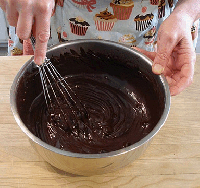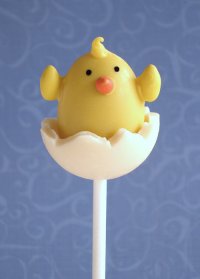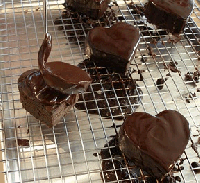Buckeyes or Chocolate Covered Peanut Butter Balls
7853 views| 0 comments
Copyright © 2000 Sarah Phillips CraftyBaking.com All rights reserved.
 Whether you know it or not, that creamy, delicately flavored chocolate stuff found in the center of a rich truffle is called ganache. You may also recognize it as a glaze on a cake, as a whipped filling or frosting or as a piped decoration.
Whether you know it or not, that creamy, delicately flavored chocolate stuff found in the center of a rich truffle is called ganache. You may also recognize it as a glaze on a cake, as a whipped filling or frosting or as a piped decoration.
SARAH SAYS: In French, the term “ganache” means fool. The story goes that it originated in It originated in France around 1850, from a mistake that a chocolatier’s apprentice made, causing the chef to call him "ganache", when he spilled cream into liquid chocolate that he was stirring.
All ganache starts out with a rich mixture made from varying proportions of chopped chocolate and boiled heavy pasteurized cream or a liquid, cooled to various degrees of temperature and mixed in certain ways, yielding different uses. Ganache can be flavored, have extra ingredients added, such as butter for richness, and corn syrup for shine and flow properties!
SARAH SAYS: So, to make thick ganache (used for tart filling, truffle centers, and as filling and/or icing for cakes and cupcakes), you add less cream. To make thin ganache (used for glazing cakes and pastries), you add more cream.
HOW GANACHE WORKS
 At first glance, it appears that ganache is a simple mixture of just two ingredients, heavy cream and chocolate. But, there's a lot more science going on behind the scenes to give you a successful ganache mixture that won't separate, become grainy, hard, crack, curdle or too firm.
At first glance, it appears that ganache is a simple mixture of just two ingredients, heavy cream and chocolate. But, there's a lot more science going on behind the scenes to give you a successful ganache mixture that won't separate, become grainy, hard, crack, curdle or too firm.
Ganache is a really a complex combination of an emulsification and a suspension that occurs between the chocolate and cream ingredients. An emulsification is a suspension of small globules of one liquid in a second liquid with which the first will not mix, ie: an emulsion of oil in vinegar or cream is an emulsion of butterfat in water. A suspension is a material in which a substance is dispersed in a liquid in clusters or particles consisting of many molecules. Nonfat milk is a suspension of milk-protein particles in water. The continuous phase of the mixture, or the "appearance" of its molecules or matter (ie: solid, liquid or gas), is a syrup made from the cream's water and the chocolate's sugar. Suspended in the syrup are the milk are the cream's fat globules and the cocoa butter's fat droplets and solid cocoa particles from the chocolate.
To emulsify the chocolate and cream, the cream is first heated which reduces its water content. The hot cream is poured over the chocolate and it melts after sitting for a few minutes. The waiting time also serves to bring down its temperature down because emulsions form better at 90 degrees to 110 degrees F. Start slowly, and then rapidly mix the ingredients together in ONE direction, starting from the outside edge moving inward. The emulsification takes place by the combination of work or stirring, which breaks down the fat in both the cream and chocolate into microscopic droplets, small enough to be suspended within the water - and the use of an emulsifier to stabilize the system, or fatty acids present in the cream or milk.
As a general rule, the higher the fat content of the cream, the richer and more stable the finished ganache will be. (The milk solids in the cream also help thicken the ganache and the butterfat lends smoothness and moistness). I like to use heavy whipping cream to make ganache. Even crème fraîche or sour cream can be used instead of heavy cream.
SARAH SAYS: I have successfully made ganache with soy milk.
SARAH SAYS: I recommend using a high quality dark chocolate, such as Valhrona or Dove, but find a chocolate you like and stick with it. If using milk or white chocolate just note that they are more temperamental; they contain milk or milk fat, unlike dark chocolate, making them more susceptible to damage from heat. Because of the milk, they also make "softer" ganache, so lessen the amount of cream used.
GANACHE TYPES
Once made, ganache needs to thicken if it will be used for anything other than a glaze. First cover with a piece of plastic wrap pressed on the top of the ganache so a film does not form, then chill the mixture in the refrigerator until it becomes thick but not firm, which takes about an hour, depending on how large or deep the storage container is.The mixture can also be set aside at the cool side of room temperature to thicken, but this takes longer than chilling in the refrigerator.
Plain ganache: Ganche can be refrigerated or set aside. Before you do, cover with a piece of plastic wrap pressed on the top of the ganache so a film does not form. If refrigerated, bring back to room temperature before using by setting in a warm place in the kitchen; it takes about an hour to soften
Whipped ganache: is used for making truffles, piping, filling or making a mousse. After making, it needs to cool to lukewarm so it thickens and will whip faster and have a better texture. Be sure the ganache is soft before beating, or it will break and curdle. Then place ganache in a mixing bowl and whip it vigorously by hand or with an electric mixer fitted with a flat beater attachment, starting on low and progressing rapidly to medium-high speed. Do this until mixture has lightened in color and is fluffy. Do not overwhip, otherwise it will become grainy. If it does, reheat the ganache in a double boiler and strain.
Ganache Icing: My favorite flavorful chocolate frosting is made by placing a piece of plastic wrap on the surface of the ganache. Store at room temperaturefor for an hour or longer, depending on the recipe - not in the refrigerator because the ganache will get too hard. Then, whip with your mixer and add 1 stick of softened butter, a tablespoon at a time. Add in 2 cups of powdered sugar slowly at the side of the bowl with the mixer running on low until the ganache is smooth. If the ganache is too stiff, add a small amount of cream, if necessary.
 Ganache Glaze: Ganache can be poured like a glaze on cakes that sets with a beautiful shine and smoothness, and also seals in freshness. You can tell if a cake has been glazed with it because it has a glossy and smooth chocolate surface. After making, let cool slightly and use immediately as a glaze. HOW TO GLAZE BAKED GOODS.
Ganache Glaze: Ganache can be poured like a glaze on cakes that sets with a beautiful shine and smoothness, and also seals in freshness. You can tell if a cake has been glazed with it because it has a glossy and smooth chocolate surface. After making, let cool slightly and use immediately as a glaze. HOW TO GLAZE BAKED GOODS.
To make: I always double the recipe in case I need extra. Four cups is enough to glaze an 8-inch cake. For pouring, the ganache mixture should be approximately 86 to 91 degrees F measured with an Instant Read Thermometer (Stir the mixture before inserting the tip of the thermometer in the center of the mixture making sure you don't touch the bottom or sides of the bowl) or feel just slightly warm -- it must remain pourable -- it should look and pour like corn syrup in order to glaze the cake or a frozen dessert. If ganaching a chilled mousse, it should be chilled thoroughly so the ganache will set quickly and not melt it.
If the ganache is too hot, press a piece of plastic wrap on the top of the ganache so a film does not form and allow it to sit at a cool, room temperature until just thickened, about 15 minutes, or so. Be careful so it does not cool too much.
ADD FLAVOR & TEXTURE
Infuse flavor to hot cream: Infuse herbs and spices, such as lavender, into the cream after heating. Then, strain before using.
Add flavor to cold cream: Mint, coffee beans and tea leaves. Chop and blend into the cold cream, and allow to sit overnight. Strain the pieces from the cream when ready to heat.
Add flavors to the ganache: Liqueurs, brandies, extracts, fruit purees, instant espresso powder, spices. I like to use Armagnac, a kind of dry brandy. Add when the warm ganache has been blended and is smooth.
Add texture to the ganache: Add chocolate nibs after the ganache has been blended and is smooth.
STORAGE
After making and for storing, always place a piece of plastic wrap firmly against its surface so a film does not form or it won't form a sugar crust on its surface. Classic ganache can generally stay at room temperature for 2 days, as long as it's kept in a cool place, and then it must be refrigerated, where it can stay for up to a month. Let it stand at room temperature to warm up. But, there are lots of exceptions to this rule. Ganache can be frozen for a month or more. Thaw in the refrigerator, and then let stand at room temperature to warm up.
Ganache is perfect to use for a cake or wedding cake that has to sit out for awhile-- to store, place under a covered cake saver or inverted bowl so as not to mar its surface.
SARAH SAYS: The storage topic about chocolate ganache is debatable. Every ganache recipe varies, and a blanket statement cannot be made as to whether it needs refrigeration or not. The final determination is made by what the recipe is, how it is made, how it is being stored, how long it is being kept for, and how it is made.
Because of its high content of sugar and fat, some feel that ganache needs refrigeration after two days IF made properly, which CraftyBaking.com endorses. If not made properly, it needs refrigeration right away, to which we agree. But, how do you know? You don't.
To be on the safe side, CraftyBaking.com recommends keeping our ganache recipes at room temperature for two days, and then refrigerating for the remainder of time. Storage information is included with all of our recipes.
Sarah's Research: A CLASSIC ganache recipe can PROBABLY be left unrefrigerated for the first 2 days if its made properly, but it has to be stored at the cool side of room temperature. Then it should be refrigerated. But, to be on the safe side, ganache has to be made properly (the emulsion formed perfectly), the temperature the cream is boiled to makes a difference (it must be brought to a full boil), the temperature and conditions it is being stored in has to be analyzed, the ratio of cream to chocolate makes an impact, the type and brand of chocolate and cream used makes a difference, and whether or not the ganache was made under sterile conditions or not. All of these variables have to be looked at at the same time, and each recipe has to be analyzed individually. (Read important discussion about)
Micro-organisms need water to grow. When the sugar content is so high, the sugar binds the water in such a way that micro-organisms cannot utilize it. Technically its called "water activity control." Some recipes call for added butter, which is fat, and corn syrup, which is sugar. As one reduces sugar or fat, then the water activity properties are reduced. In general, to reduce sugar and keep water activity control, fat has to be increased. (That's why bakery or confection "low fat" items are loaded with sugar and "low carb" items are loaded with fat.)
7853 views| 0 comments
18142 views| 4 comments
12039 views| 38 comments